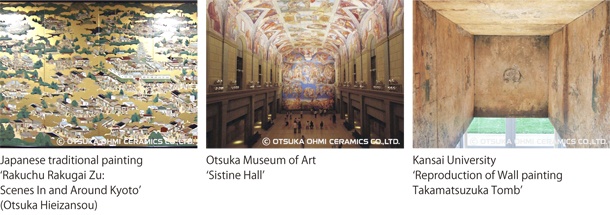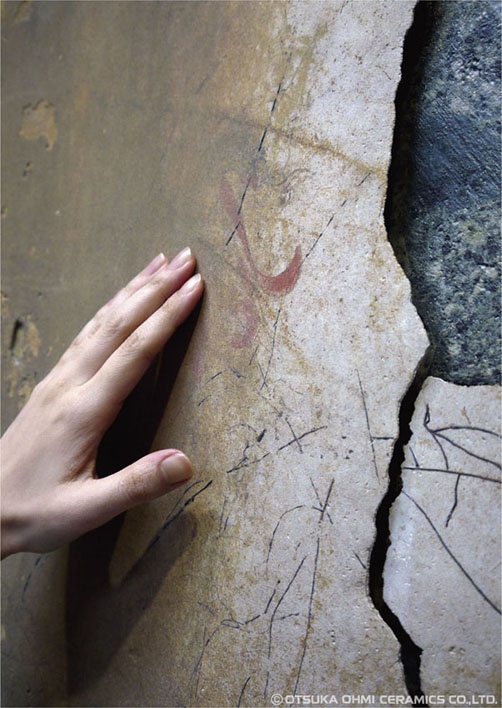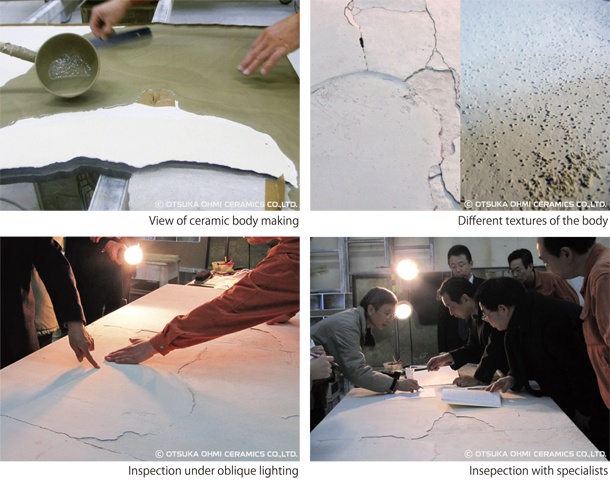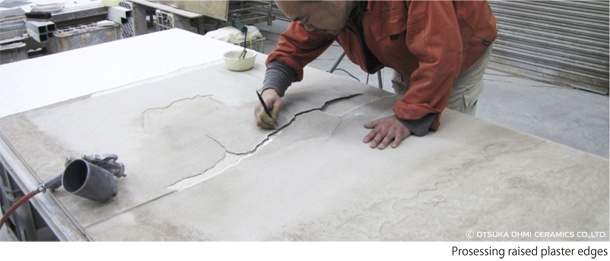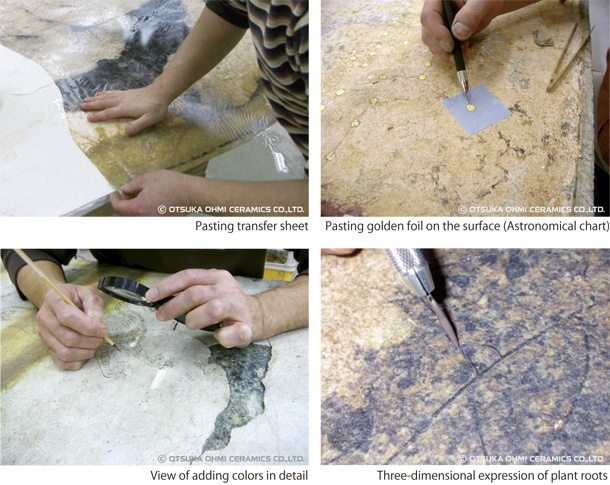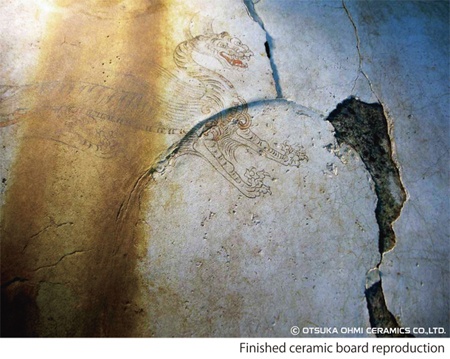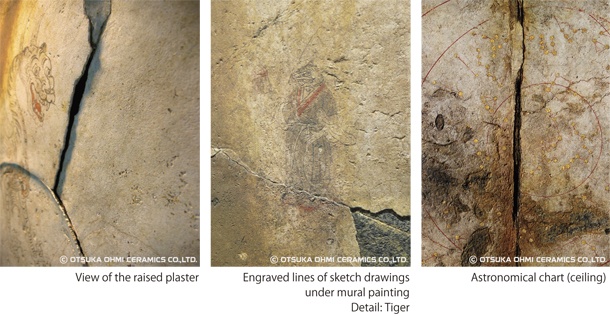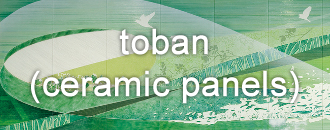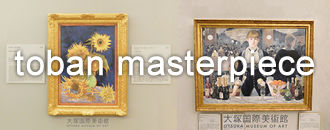Commission by the Agency for Cultural Affairs
Since our company was founded in 1973, we have created and reproduced many original pieces, collaboration works with artists and traditional Japanese paintings.
Above all, the opening of the Otsuka Museum of Art in 1998 represented a compilation of our reproduction technologies in architecture, paintings and wall murals.
We have also created reproductions of such historic sites, ‘Cave 323 of The Mogao Caves (Gansu, China)’, ‘Pranidhi scene 14 of Bezeklik’ and ‘The Takamatsuzuka Tomb (Nara, Japan)’.
Those achievements and our technological capability were highly praised by the Agency for Cultural Affairs, and we were commissioned to reproduce Kitora Tomb Stone Chamber’in 2009. The reproduction consists of 6 wall parts, Blue Dragon on East wall, White Tiger on West wall, Vermilion Bird on South wall, Black Tortoise on North wall, the ceiling and the floor.
However, this mission was very different from other projects in many aspects, both in quality and detail. That is this Ceramic Board Reproduction.
▶ Visit the page: Achievements, Otsuka Ohmi Ceramics Co., Ltd
What is Kitora Tomb?
Kitora Tomb
Special Historic Site Kitora Tomb has murals in its stone chamber; an astronomical chart on the ceiling, and four gods and twelve zodiac animals on the walls. The Kitora Tomb is believed to have been constructed between the 7th and early 8th centuries. It was found in the south side slopes of Mt. Abe located in the south of Takamatsuzuka Tomb in Asuka village, Nara prefecture in Japan.
Kitora Tomb Stone Chamber is decorated with vividly colored 1300-year-old mural paintings. It is the second of such historical asset in Japan, first being the Takamatsuzuka mural painting, and it was designated as a National Historic Site in year 2000.
Murals at present
However, the murals had already suffered from severe deterioration. Its preservation became the highest priority, and the murals had to be urgently removed.
At present, all the murals have been removed, and the murals are under restoration and preservation. The surrounding area of the stone chamber has been buried again and closed up. Therefore, no one is able to view the inside of the stone chamber.
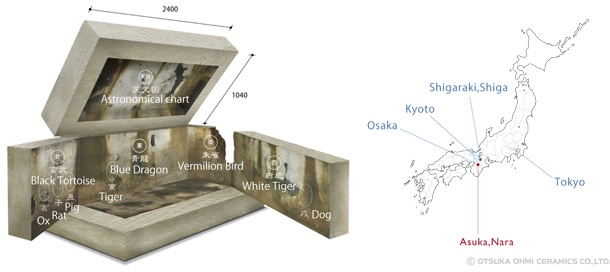
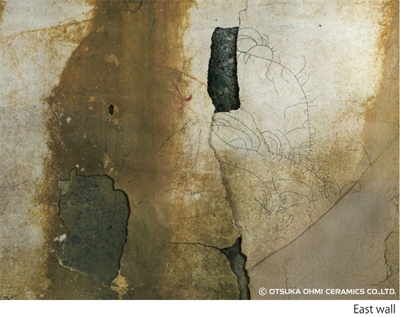 Can you see the difference- ceramic reproduction or original work?
Can you see the difference- ceramic reproduction or original work?
From Discussions with Specialists
The ceramic reproduction was created based on 30,000 pieces of image data including the hi-resolution digital photo-map provided by the Agency for the Cultural Affairs and photographs taken under oblique lighting.
The reproduction was carried out through many discussions with specialists from the Reproduction Committee appointed by the Agency for the Cultural Affairs and the staffs who had engaged in removal of the murals at the forefront.
We were able to learn more from their lively stories from the time of investigation in those days. Image data only could not convey a certain feel of the stone chamber, for instance, the way the plant roots sneaked into the stone chamber, how the plaster walls deteriorated like cracked egg-shells and the moist ceiling had different color texture than other walls. All the discoveries from the conversations were recorded in our‘Writing Panel’.
We were granted a special permission to go inside of the stone chamber and to see the original murals that were under repair. Those first-hand experiences to feel the special ambience of the stone chamber helped us greatly in creation of the reproduction.
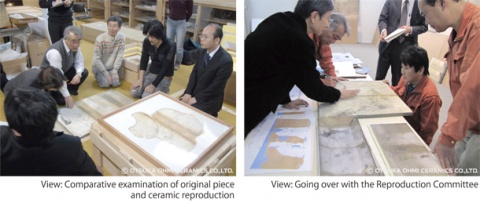
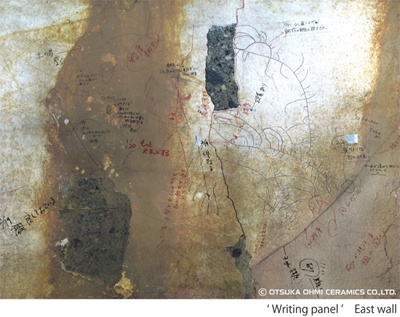 Comments were directly written on the real size photo-map.
Comments were directly written on the real size photo-map.
Reproduction Process
Firing process causes ceramics to shrink approximately 10%. During the firing process, ceramics may crack or distort in shape, which were not there before firing.
The level of such a risk and difficulty increases as the size of ceramics gets larger and its shape becomes flat and thinner.
Ceramic Body making
We change combination of clays depending on the product and its use. For this project, we were requested for a faithful detailed reproduction, and we specially combined fine grains that are easy to process.
Engobe was put onto the body and its surface was made smooth. In order to reproduce the various looks of the walls, we used different sizes of grains in engobe depending on the surface area.
The concavities and convexities of the walls were recreated using oblique lightning. By replicating the exact same shadows shown in the oblique light photographs, we strived to create three-dimensional representation of plaster walls.
With a knife and a pallet, we elaborately recreated the concavities and convexities of the wall surface and engraved sketch drawings of four gods and twelve zodiac animals.
Making of Color Image Transfer Sheet
After firing the ceramic body produced through these processes, transfer sheet is pasted onto it.
The images on transfer sheets were recreated based on the photo-map composed of high-resolution digital photographs taken at the time of excavation and investigation. This photo-map is an important data on which restoration of the original murals are based on.
The photo-map image data are then separated into 4 colors of CMYK (cyan, magenta, yellow and black), then individual printing plate is created for silk screen printing. Using special paint for ceramics, the image is printed on transfer sheet.
In order to get close to the final product, we went through repeated color adjustments and a number of trial pieces.
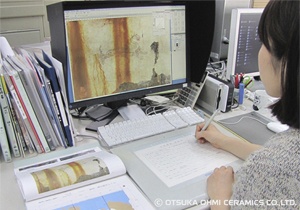 View of color separation
View of color separation 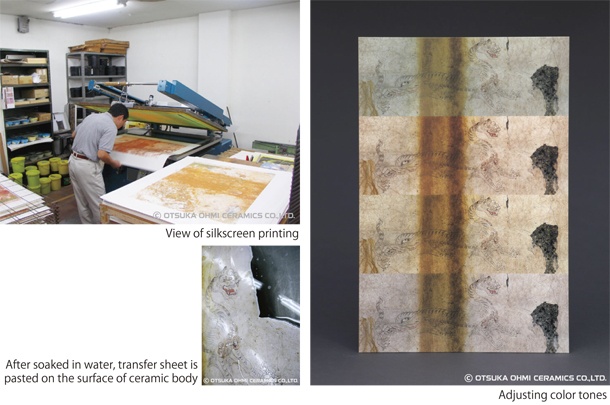
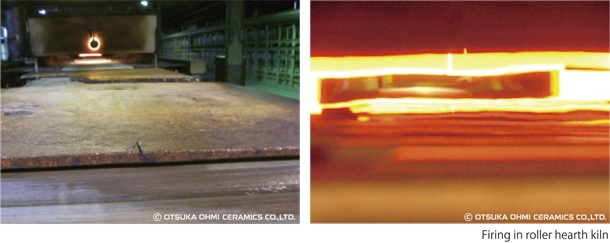
Finishing touch by Artisan
The finished transfer sheet is carefully pasted on the ceramic surface with careful attention to its concavities and convexities. After firing the ceramic body with transfer sheet, additional colors are applied using a brush.
How the color of the paint comes out varies depending on its thickness, and we never know how the colors of paint come out until the firing is completed. Artisans apply additional colors, guided by their intuition and long experience.
By repeating this process several times, we aim to faithfully reproduce the color tones of the original. The heat-resistant characteristics of our ceramic boards make this repeated firing process possible.
Even the bulging of plant roots crawling on the wall was reproduced and pieces of golden foil were meticulously pasted one by one to represent the starts in the astronomical chart on the ceiling.
Completion of reproduction process
Through these multiple steps, the finished ceramic boards faithfully reproduced detailed features of the original, from the curves of the ceiling, engraved lines of sketch drawings under the murals, to the raised plaster peeling off the wall.
We succeeded in reproducing even subtle differences in wall textures, such as mud covered surface and traces of rainwater.
Ceramic Board for Recording and Preserving
The advantage of ceramic reproduction is not limited to its capability in depicting precise details.
Ceramic reproduction is suitable for long-term preservation because of their strength, durability, resistance to color fading over time, and relatively easy maintenance. Such characteristics enable preservation of articraft in the same condition as they were at the time of creation, and we can share them with the future generation.
Our ceramic boards are the largest in the world and require the least number of joints between ceramic panels. As we reduced the number of joints that could get in the way of overall view, our ceramic boards are best suited for a reproduction in actual scale, especially a large scale reproduction like this project.
Additionally, the walls can be assembled and adjustable so that people can feel the ambience of the stone chamber in those days.
This was made possible by our innovative construction method and ceramic boards with high dimensional accuracy.
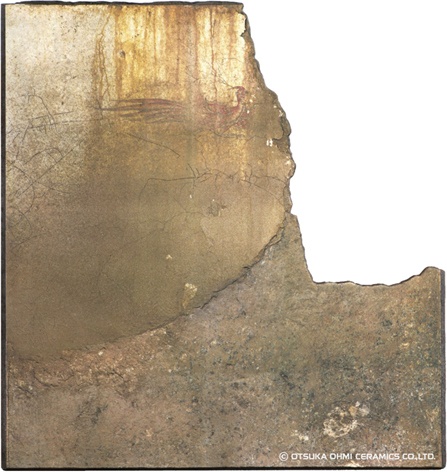 Reproduced South wall (Vermilion Bird)
Reproduced South wall (Vermilion Bird)
The inside of the stone chamber reproduced in ceramic board is expressed in wet color of 100% humidity, the same humidity level as the original murals used to be in.
Now this ceramic board reproduction is the only display of the three-dimensional original image of the stone chamber before the removal of murals.
Specialists gave high praise to our reproduction capability and commented as below:
‘I can almost feel the real ambience in the stone chamber at that time.’
‘This reproduction tempts me to peel this plaster off.’
(because of the background that the original murals have been removed)
‘Ceramic board reproduction by Otsuka Ohmi Ceramics has huge potential in preservation of cultural assets such as mural paintings that are difficult to carry and move’.
 A panoramic view of the inside
A panoramic view of the inside 
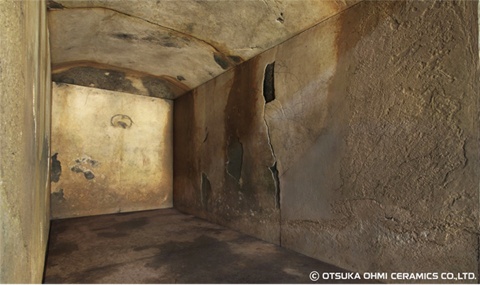 Inside view of the reproduced stone chamber
Inside view of the reproduced stone chamber
Ceramic Board Reproduction of Kitora Tomb Stone Chamber
Copyright©2014 OTSUKA OHMI CERAMICS CO., LTD. All Right Reserved.
*Download PDF files
◆ vol.1:Comission by the Agency for Cultural Affairs/ What is Kitora Tumulus? (1.8MB)
◆ vol.2:From Discussion with Specialists/ Production Process (1.3MB)
◆ vol.3:Completion of reproduction Process/ Ceramic Board for Recording and Preserving (2MB)
※ Unauthorized copying and replication of the contents of this report, text and images are strictly prohibited.
